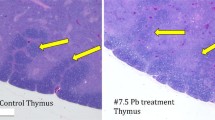Abstract
The effects of a 3-week dietary exposure to automotive waste crankcase oil (WCO) were examined in 1-week-old mallard (Anas platyrhynchos) ducklings and pheasant (Phasianus colchicus) chicks. Treatment groups consisted of birds exposed to 0.5, 1.5, or 4.5% WCO, to 4.5% clean crankcase oil (CCO), or untreated controls. In both species, red blood cell ALAD activity was significantly inhibited after one week by 50 to 60% in the 0.5% WCO group and by 85 to 90% in the 4.5% WCO group due to the presence of lead. Growth, hematocrit, and hemoglobin were not significantly affected at the end of three weeks. Plasma aspartate aminotransferase (AST) activity was higher in mallards after three weeks of ingesting either 4.5% WCO or 4.5% CCO, suggesting an oil-related effect due to components other than lead. Treatment had no effect on plasma concentration of uric acid, glucose, triglycerides, total protein, or cholesterol. Lead analysis showed the WCO to contain 4,200 ppm Pb and the CCO to contain 2 ppm. Tissues of mallards were examined for accumulation of lead and the order of accumulation at the end of three weeks was kidney > liver > blood ∼ brain.
Similar content being viewed by others
References
API: Energy from used lubricating oils. American Petroleum Institute publication No. 1588, Washington, DC (1975).
AOAC, Association of Official Analytical Chemists: Official methods of analysis, 13 ed., 25.068-25.073. Washington, DC (1980).
Borgese, T. A., and J. F. Bertles: Hemoglobin heterogeneity: Embryonic hemoglobin in the duckling and its disappearance in the adult. Science148, 509 (1965).
Burch, H. B., and A. L. Siegel: Improved method for measurement of delta-aminolevulinic acid dehydratase activity of human eryrthrocytes. Clin. Chem.17, 1038 (1971).
Dieter, M. P., M. C. Perry, and B. M. Mulhern: Lead and PCBs in canvasback ducks: Relationships between enzyme levels and residues in blood. Arch. Environ. Contam. Toxicol.5, 1 (1976).
Edens, F. W., E. Benton, S. J. Bursian, and G. W. Morgan: Effect of dietary lead on reproductive performance in Japanese quail,Coturnix coturnix japonica. Toxicol. Appl. Pharmacol.38, 307 (1976).
Finley, M. T., and M. P. Dieter: Sublethal effects of chronic lead ingestion in mallard ducks. J. Toxicol. Environ. Health1, 929 (1976).
Finley, M. T., M. P. Dieter, and L. N. Locke: δ-aminolevulinic acid dehydratase: Inhibition in ducks dosed with lead shot. Environ. Res.12, 243 (1976).
Hartung, R., and G. S. Hunt: Toxicity of some oils to waterfowl. J. Wildl. Manage.30, 564 (1966).
Hedtke, S. F., and F. A. Puglisi: Effects of waste oil on the survival and reproduction of the American Flagfish,Jordanella floridaae. Can. J. Fish. Aquat. Sci.37, 757 (1980).
Hoffman, D. J., W. C. Eastin, Jr., and M. L. Gay: Embryotoxic and biochemical effects of waste crankcase oil on birds' eggs. Toxicol. Appl. Pharmacol.63, 230 (1982)
Hoffman, D. J., O. H. Pattee, S. N. Wiemeyer, and B. Mulhern: Effects of lead shot ingestion on δ-aminolevulinic acid dehydratase activity, hemoglobin concentration, and serum chemistry in bald eagles. J. Wildl. Dis.17, 423 (1981).
Hunter, J. V., T. Sabatino, R. Gomperts, and M. J. Mackenzie: Contribution of urban runoff to hydrocarbon pollution. J. Water Poll. Control Fed.51, 2129 (1979).
Hutton, M., and G. T. Goodman: Metal contamination of feral pigeonsColumba livia from the London area: Part 1-tissue accumulation of lead, cadmium, and zinc. Environ. Pollut. (Ser. A)22, 207 (1980).
Kirk, R. E.: Experimental design: procedures for the behavioral science, p 88. Belmont, CA: Brooks/Cole Publishing Co. (1968).
Morgan, G. W., F. W. Edens, P. Thaxton, and C. R. Parkhurst: Toxicity of dietary lead in Japanese quail. Poultry Sci.54, 1636 (1975).
Ohi, G., H. Seki, K. Akiyama, and H. Yagyu: The pigeon, a sensor of lead pollution. Bull. Environ. Contam. Toxicol.12, 92 (1974).
Osweiler, G. D., W. B. Buck, and W. E. Lloyd: Epidemiology of lead poisoning in cattle-a five-year study in Iowa. Clin. Toxicol.6, 367 (1973).
Pattee, O. H., S. N. Wiemeyer, B. M. Mulhern, L. Sileo, and J. W. Carpenter: Experimental lead shot poisoning in bald eagles. J. Wildl. Manage.45, 806 (1981).
Payne, J. F., I. Martins, and A. Rahimtula: Crankcase oils: Are they a major mutagenic burden in the aquatic environment? Science200, 329 (1978).
Rattner, B. A.: Tolerance of adult mallards to subacute ingestion of crude petroleum. Toxicol. Lett.8, 337 (1981).
Rozman, R. S., L. N. Locke, and S. F. McClure: Enzyme changes in mallard ducks fed iron or lead shot. Avian Dis.18, 435 (1974).
Stone, C. L., M. R. S. Fox, A. L. Jones, and K. R. Mahaffey: δ-aminolevulinic acid dehydratase-a sensitive indicator of lead exposure in Japanese quail. Poultry Sci.56, 174 (1977).
Tanacredi, J. T.: Petroleum hydrocarbons from effluents: Detection in marine environment. J. Water Poll. Control Fed.49, 216 (1977).
Author information
Authors and Affiliations
Rights and permissions
About this article
Cite this article
Eastin, W.C., Hoffman, D.J. & O'Leary, C.T. Lead accumulation and depression of δ-aminolevulinic acid dehydratase (ALAD) in young birds fed automotive waste oil. Arch. Environ. Contam. Toxicol. 12, 31–35 (1983). https://doi.org/10.1007/BF01054998
Received:
Accepted:
Issue Date:
DOI: https://doi.org/10.1007/BF01054998




